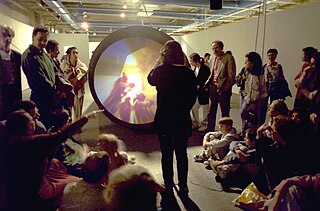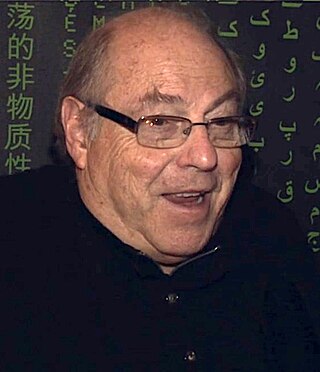
Interactive art is a form of art that involves the spectator in a way that allows the art to achieve its purpose. Some interactive art installations achieve this by letting the observer walk through, over or around them; others ask the artist or the spectators to become part of the artwork in some way.
Software art is a work of art where the creation of software, or concepts from software, play an important role; for example software applications which were created by artists and which were intended as artworks. As an artistic discipline software art has attained growing attention since the late 1990s. It is closely related to Internet art since it often relies on the Internet, most notably the World Wide Web, for dissemination and critical discussion of the works. Art festivals such as FILE Electronic Language International Festival, Transmediale (Berlin), Prix Ars Electronica (Linz) and readme have devoted considerable attention to the medium and through this have helped to bring software art to a wider audience of theorists and academics.

Electronic art is a form of art that makes use of electronic media. More broadly, it refers to technology and/or electronic media. It is related to information art, new media art, video art, digital art, interactive art, internet art, and electronic music. It is considered an outgrowth of conceptual art and systems art.
Information art, which is also known as informatism or data art, is an art form that is inspired by and principally incorporates data, computer science, information technology, artificial intelligence, and related data-driven fields. The information revolution has resulted in over-abundant data that are critical in a wide range of areas, from the Internet to healthcare systems. Related to conceptual art, electronic art and new media art, informatism considers this new technological, economical, and cultural paradigm shift, such that artworks may provide social commentaries, synthesize multiple disciplines, and develop new aesthetics. Realization of information art often take, although not necessarily, interdisciplinary and multidisciplinary approaches incorporating visual, audio, data analysis, performance, and others. Furthermore, physical and virtual installations involving informatism often provide human-computer interaction that generate artistic contents based on the processing of large amounts of data.
Adrian Ward is a software artist and musician. He is known for his generative art software products released through his company Signwave, and as one third of the techno gabba ambient group, Slub. His theoretical approach to generative and software art guides his practice, including contributing to the early principles of the livecoding movement.

Experiments in Art and Technology (E.A.T.), a non-profit and tax-exempt organization, was established in 1967 to develop collaborations between artists and engineers. The group operated by facilitating person-to-person contacts between artists and engineers, rather than defining a formal process for cooperation. E.A.T. initiated and carried out projects that expanded the role of the artist in contemporary society and helped explore the separation of the individual from technological change.

Roy Ascott FRSA is a British artist, who works with cybernetics and telematics on an art he calls technoetics by focusing on the impact of digital and telecommunications networks on consciousness. Since the 1960s, Ascott has been a practitioner of interactive computer art, electronic art, cybernetic art and telematic art.

Frank Popper was a Czech-born French-British historian of art and technology and Professor Emeritus of Aesthetics and the Science of Art at the University of Paris VIII. He was decorated with the medal of the Légion d'honneur by the French Government. He is author of the books Origins and Development of Kinetic Art, Art, Action, and Participation, Art of the Electronic Age and From Technological to Virtual Art.

Rebecca Allen is an American digital artist inspired by the aesthetics of motion, the study of perception and behavior and the potential of advanced technology. Her artwork takes the form of experimental video, large-scale performances, live simulations and virtual and augmented reality art installations. It addresses issues of gender, identity and what it means to be human as technology redefines our sense of reality.

Maurice Benayoun is a French new-media artist, curator, and theorist based in Paris and Hong Kong.

Virtual art is a term for the virtualization of art, made with the technical media developed at the end of the 1980s. These include human-machine interfaces such as visualization casks, stereoscopic spectacles and screens, digital painting and sculpture, generators of three-dimensional sound, data gloves, data clothes, position sensors, tactile and power feed-back systems, etc. As virtual art covers such a wide array of mediums it is a catch-all term for specific focuses within it. Much contemporary art has become, in Frank Popper's terms, virtualized.

Mel Alexenberg is an American-Israeli artist, art educator, and writer recognized for his pioneering work exploring the intersections of art, science, technology and digital culture. He experimental with digital fine art prints in the 1980s that are in 30 museum collections worldwide, circumglobal cyberangel flights honoring Rembrandt in 1989 and in 2019.

Dominique Moulon is a historian of art and technology, art critic and curator, specializing in French digital art. He is the author of the books Art contemporain nouveaux médias and Art Beyond Digital.
Technoetics is a neologism introduced by Roy Ascott, who coined the term from techne and noetic theory, to refer to the emergent field of technology and consciousness research.

Internet art is a form of new media art distributed via the Internet. This form of art circumvents the traditional dominance of the physical gallery and museum system. In many cases, the viewer is drawn into some kind of interaction with the work of art. Artists working in this manner are sometimes referred to as net artists.

Maurizio Bolognini is a post-conceptual media artist. His installations are mainly concerned with the aesthetics of machines, and are based on the minimal and abstract activation of technological processes that are beyond the artist's control, at the intersection of generative art, public art and e-democracy.

New media art includes artworks designed and produced by means of electronic media technologies. It comprises virtual art, computer graphics, computer animation, digital art, interactive art, sound art, Internet art, video games, robotics, 3D printing, immersive installation and cyborg art. The term defines itself by the thereby created artwork, which differentiates itself from that deriving from conventional visual arts such as architecture, painting or sculpture.

Glitch art is an art movement centering around the practice of using digital or analog errors, more so glitches, for aesthetic purposes by either corrupting digital data or physically manipulating electronic devices. It has been also regarded as an increasing trend in new media art, with it retroactively being described as developing over the course of the 20th century onward.
Post-conceptual, postconceptual, post-conceptualism or postconceptualism is an art theory that builds upon the legacy of conceptual art in contemporary art, where the concept(s) or idea(s) involved in the work take some precedence over traditional aesthetic and material concerns. The term first came into art school parlance through the influence of John Baldessari at the California Institute of the Arts in the early 1970s. The writer Eldritch Priest, specifically ties John Baldessari's piece Throwing four balls in the air to get a square from 1973 as an early example of post-conceptual art. It is now often connected to generative art and digital art production.
Ryota Matsumoto is a Japanese artist, writer, and educator. He is known as the theorist of the postdigital movement and hybrid art. He has been an adjunct professor at the Transart Institute for Creative Research, University of Plymouth and serves as a research associate at the New Centre of Research and Practice. He is a fellow of British Art Network and the City of Dallas Office of Arts and Culture. Besides his solo work, he has collaborated with Kisho Kurokawa, Peter Christopherson, and MIT Media Lab.












